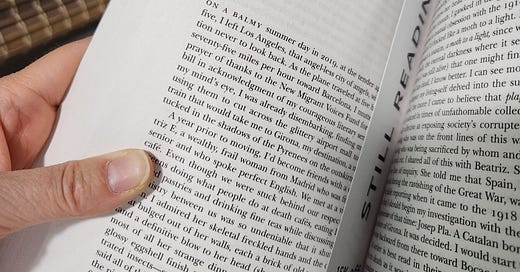“Extinction” must be one of the stories Lauren Groff was looking for when she told Best American editor Heidi Pitlor she was looking for “more stories that took ‘wild swings, risks, pushing against narrative expectations.’” This post-pandemic story is partly about a 25-year-old’s premonition that the pandemic is coming. She’s grown up in a family of chronic illness in which she is the only healthy one—but now she’s obsessed with death, and with the 1918 pandemic and the Spanish “plague writer” Josep Pla and a much older online friend named Beatriz. Moreover, our narrator is dead, giving her insights into life. All of which is something of a “wild swing.” So, I loved that about this story. If I’d had a pencil while reading, I would have underlined what I think may serve as the central question of this story: What does it mean to write when the world is on the cusp of vanishing? It’s a question the narrator calls “inconsequential,” which I suppose is true if the world is literally vanishing. But it does seem to gather up what’s happening here. Unfortunately, the subject of writing itself is usually more urgent for the writer than for the reader. One odd thing about this story apart from its quirky characters and situation is that from the first sentence I was tripping over clichés. I debated whether this was a case of bad writing, but I’ve learned to give writers the benefit of the doubt, and there are so many clichés that I concluded they must be intentional, a subtle commentary maybe on the question about what it means to write at all. Could any combination of words really be birthed anew? I found “Extinction” interesting. There’s a lot going on in these 13-and-a-half pages and, probably like all of the stories in Best American, it’s worth a closer look.
We’re already entering the last week of this shortest month! I plan to read another writer whose work I don’t already know: Marie-Helene Bertino, and her story “Viola in Midwinter.” Join me in reading this or another story from The Best American Short Stories of 2024.
In the meantime, what are you reading this week? Have you read “Extinction” or another story from Best American? Let us know in the comment section below!





And a thanks to whoever mentioned "Eastbound" by Maylis de Kerangal with Jessica Moore - great novella.
I was in Puerto Rico this past week. When I vacation, I like to read books set in that location and preferably by an author from there. Before I left, I read a book about the history of Puerto Rico. While traveling, I finished two books by Puerto Rican authors.
I read Esmeralda Santiago’s 1993 memoir When I Was a Puerto Rican. She tells the story of her early childhood in Puerto Rico and her experience of cultural adjustment in the U.S. when her mother moves her and her siblings to New York City. The time period is the 1950s -1960s. Santiago infused her family’s internal and economic struggles with appreciation for Puerto Rican culture.
The second book is Rosario Ferre’s Sweet Diamond Dust and Other Stories , a historical fiction collection. The novella Sweet Diamond Dust is a three-generation story of a sugar cane mill family. Three other long stories follow, each with one or more descendants as characters. All are conflict driven - greed and generosity, history and tradition and change, race and religion and social status, freedom/independence and colonialism, and subsequent family and personal strife - with the political/economic history of Puerto Rico as their base.
Neither was a quick, easy, happy beach read. But if you want insight into Puerto Rico’s history and culture and immigration, these are worth reading.